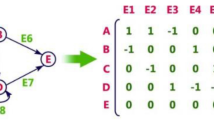Abstract
A Justified Plan Graph (JPG) method uses graph mathematics to measure the connectivity properties of an architectural plan, providing insights into how a building may have been used, or how it differs from other buildings. The standard JPG method has several practical limitations that are evident when it is used to study relatively simple planning, of the type found in Palladian villas. This paper introduces two new approaches that use weighted and directed centrality measures and that can provide a different type of plan graph analysis to accommodate the types of spatial properties and behaviours exhibited by visitors to and inhabitants of Palladio’s villas. In this paper a comparison of the results of the standard JPG and the new weighted and directed JPG is developed for five Palladian villa plans. The results are used to highlight the differences between the two approaches and to suggest some implications for future readings of the planning of Palladian villas.


(Source: Authors’ elaboration)


(Source: Authors’ elaboration)


(Source: Authors’ elaboration)


(Source: Authors’ elaboration)


(Source: Authors’ elaboration)

Similar content being viewed by others
References
Alexander, Christopher, Sara Ishikawa, and Murray Silverstein. 1977. A Pattern Language: towns, buildings, construction. New York: Oxford University Press.
Borgatti, Stephen P. 2005. Centrality and network flow. Social Networks 27, 1:55-71. https://doi.org/https://doi.org/10.1016/j.socnet.2004.11.008.
Crucitti, Paolo, Vito Latora, and Sergio Porta. 2006. Centrality measures in spatial networks of urban streets. Physical Review E 73, 3:036125. https://doi.org/https://doi.org/10.1103/PhysRevE.73.036125.
Dawes, Michael J., Michael J. Ostwald, and Ju Hyun Lee. 2021. Examining control, centrality and flexibility in Palladio’s villa plans using space syntax measurements. Frontiers of Architectural Research 10, 3:467-482. https://doi.org/10.1016/j.foar.2021.02.002.
Freeman, Linton C. 1978. Centrality in social networks conceptual clarification. Social Networks 1, 3:215-239. https://doi.org/https://doi.org/10.1016/0378-8733(78)90021-7.
García-Salgado, Tomás. 2008. A Perspective Analysis of the Proportions of Palladio’s Villa Rotonda: Making the Invisible Visible. Nexus Network Journal 10, 2:269-282. https://doi.org/https://doi.org/10.1007/s00004-007-0069-3.
Giaconi, Giacomo, and Kim Williams. 2003. The Villas of Palladio. New York: Princeton Architectural Press.
He, Matthew, and Sergey Petoukhov. 2011. Mathematics of Bioinformatics: Theory, Methods and Applications. Hoboken, Hew Jersey: John Wiley & Sons.
Hersey, George L., and Richard Freedman. 1992. Possible Palladian Villas: (Plus a Few Instructively Impossible Ones). Cambridge, MA: The MIT Press.
Hillier, Bill, and Julienne Hanson. 1984. The Social Logic of Space. Cambridge: Cambridge University Press.
Hillier, Bill, Julienne Hanson, and H. Graham. 1987. Ideas are in things: an application of the space syntax method to discovering house genotypes. Environment and Planning B: Planning and Design 14, 4:363-385.
Lee, Ju Hyun, and Michael J. Ostwald. 2020. Grammatical and Syntactical Approaches in Architecture: Emerging Research and Opportunities. Hershey, PA: IGI Global.
Klarqvist, Björn. 1993. A Space Syntax Glossary. Nordisk Arkitekturforskning 2:11-12.
March, Lionel. 2001. Palladio’s Villa Emo: The Golden Proportion Hypothesis Rebutted. Nexus Network Journal 3, 2:85-104. https://doi.org/https://doi.org/10.1007/s00004-001-0024-7.
Mitrović, Branko, and Ivana Djordjević. 1990. Palladio’s Theory of Proportions and the Second Book of the “Quattro Libri dell’Architettura”. Journal of the Society of Architectural Historians 49, 3:279-292. https://doi.org/https://doi.org/10.2307/990519.
Opsahl, Tore, Filip Agneessens, and John Skvoretz. 2010. Node centrality in weighted networks: Generalizing degree and shortest paths. Social Networks 32, 3:245-251. https://doi.org/https://doi.org/10.1016/j.socnet.2010.03.006.
Ostwald, Michael J. 2011. The Mathematics of Spatial Configuration: Revisiting, Revising and Critiquing Justified Plan Graph Theory. Nexus Network Journal 13, 2:445-470. https://doi.org/https://doi.org/10.1007/s00004-011-0075-3.
Pafka, Elek, Kim Dovey, and Gideon D. P. A. Aschwanden. 2020. Limits of space syntax for urban design: Axiality, scale and sinuosity. Environment and Planning B: Urban Analytics and City Science 47, 3:508-522. https://doi.org/https://doi.org/10.1177/2399808318786512.
Palladio, Andrea. 1570. I Quattro libri dell'architettura. Venetia: Domenico de' Franceschi.
Peponis, John, Sonit Bafna, Saleem Mokbel Dahabreh, and Fehmi Dogan. 2015. Configurational meaning and conceptual shifts in design. The Journal of Architecture 20, 2:215-243. https://doi.org/https://doi.org/10.1080/13602365.2015.1025814.
Smienk, Gerrit, Johannes Niemeijer, Hans Venema and Frits van Dongen. 2011. Palladio, the Villa and the Landscape. Basel: Birkhauser.
Tikhonova, Olha. 2019. New Approach to Proportional Analysis of Palladio’s Designs in Book II with Particular Attention to Loggias. Nexus Network Journal 21, 2:359-381. https://doi.org/https://doi.org/10.1007/s00004-019-00445-4.
White, Douglas R., and Stephen P. Borgatti. 1994. Betweenness centrality measures for directed graphs. Social Networks 16, 4:335-346. https://doi.org/https://doi.org/10.1016/0378-8733(94)90015-9.
Zheng, X., L. Zhao, M. Fu, and S. Wang. 2008. Extension and Application of Space Syntax A Case Study of Urban Traffic Network Optimizing in Beijing. In 2008 Workshop on Power Electronics and Intelligent Transportation System, eds. Qi Luo, and Weitao Zheng, 291–295. China, Guangzhou: IEEE.
Acknowledgements
This research was supported by UNSW Scientia Academic (Research) program.
Author information
Authors and Affiliations
Corresponding author
Additional information
Publisher's Note
Springer Nature remains neutral with regard to jurisdictional claims in published maps and institutional affiliations.
About this article
Cite this article
Lee, J.H., Ostwald, M.J. & Dawes, M.J. Examining Visitor-Inhabitant Relations in Palladian Villas. Nexus Netw J 24, 315–332 (2022). https://doi.org/10.1007/s00004-021-00589-2
Accepted:
Published:
Issue Date:
DOI: https://doi.org/10.1007/s00004-021-00589-2




